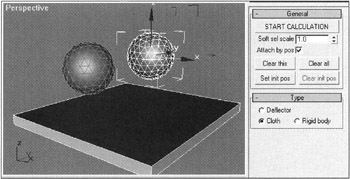SimCloth
|
| < Day Day Up > |
|
This module, developed by the Chaos Group, was initially intended to simulate various types of cloth. Later, however, it also integrated the ability to imitate the dynamics of soft and hard physical bodies. It should be noted that, from a physical accuracy point of view, commercial products such as Stitch do much better. However, like the Combustion Stuff module, it is advantageous in terms of its widespread use and because it is free. The developers have kindly provided us with version 2.52 (version 2.51 is available on their website at http:www.chaosgroup.com/). You must install it with a program on the companion CD-ROM (in the \Plugins\SimCloth\ folder). Follow the instructions on the screen.
You might encounter some difficulties when starting to work with this module. We will therefore discuss it in more detail.
-
Create a scene similar to the one shown in Fig. 21.6 — a single Box object and two spheres of the Geosphere type. The second condition is important, since the module requires Cloth objects to have a regular mesh to work correctly.

Figure 21.6: Example using the SimCloth module -
Position the spheres above the box's surface.
-
Select all objects and apply the SimClothMod modifier. Disassociate the objects by clicking the Make Unique button in the modifier stack.

-
For one of the spheres, select the Cloth type; for the second, select Rigid body; for the box, select the Deflector type.
-
Click the Start Calculation button. Note that it doesn't matter which object is selected. One of the spheres will fall to the surface of the box, while the second will fall and crumple.
The module comes with comprehensive documentation illustrated by a large number of examples. We therefore won't discuss its parameters here but, rather, will draw your attention to two aspects. First, you need to make sure that there are no intersections between objects or between an object and itself (unless this is desirable). If there are, and the module is unable to handle the situation, increase Min. Subdivs and Max. Subdivs in the Simulation group. This increases the calculation time but also improves accuracy.
The second aspect is the fact that the object's pivot point retains its position during calculation. Thus, you can animate the object however you'd like afterward. On the other hand, the animation recorded before the calculation is lost (to be more precise, it is distorted), except when the object is of a deflector type.
And, finally, it should be mentioned that this module has one rather unpleasant drawback: You cannot record its settings for future use. Therefore, you have to adjust it from scratch each time you use it.
|
| < Day Day Up > |
|
EAN: N/A
Pages: 136
- Challenging the Unpredictable: Changeable Order Management Systems
- ERP System Acquisition: A Process Model and Results From an Austrian Survey
- Enterprise Application Integration: New Solutions for a Solved Problem or a Challenging Research Field?
- Distributed Data Warehouse for Geo-spatial Services
- A Hybrid Clustering Technique to Improve Patient Data Quality